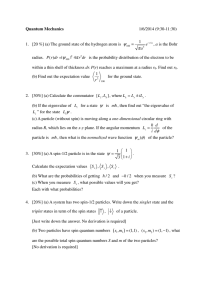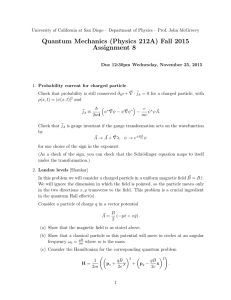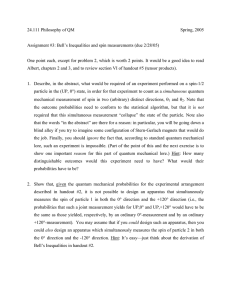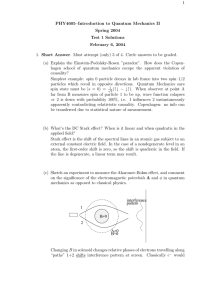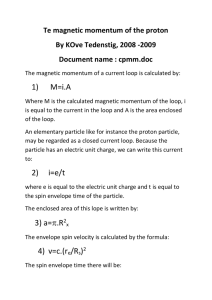PHY4605–Introduction to Quantum Mechanics II Spring 2004 Test 1 February 6, 2004
advertisement
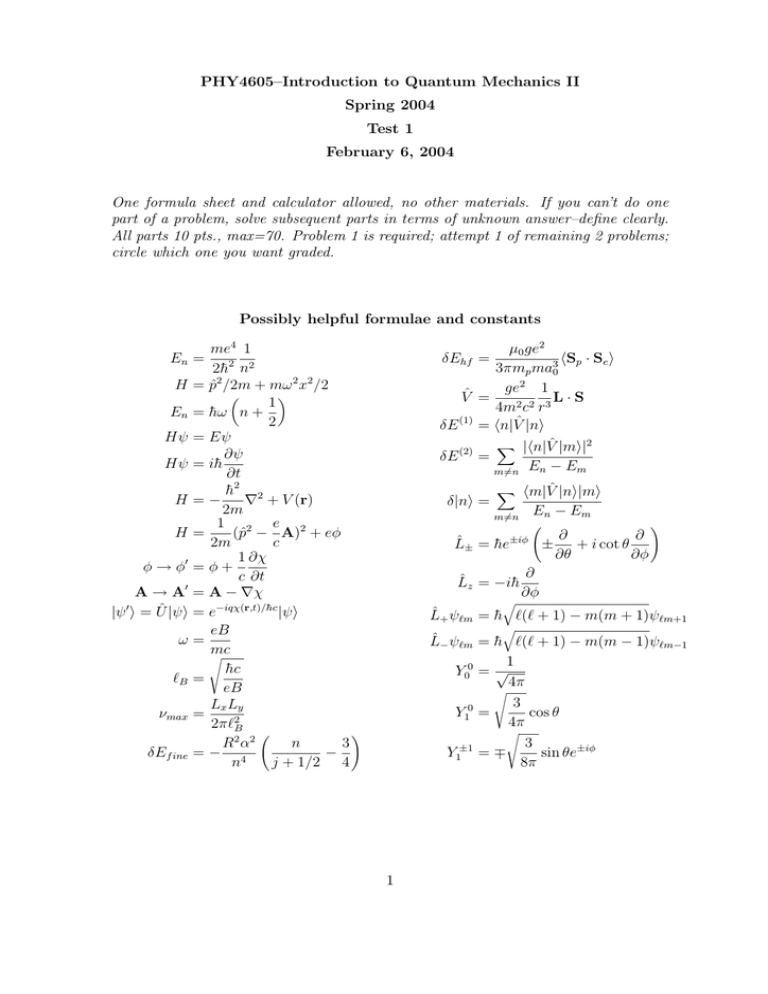
PHY4605–Introduction to Quantum Mechanics II Spring 2004 Test 1 February 6, 2004 One formula sheet and calculator allowed, no other materials. If you can’t do one part of a problem, solve subsequent parts in terms of unknown answer–define clearly. All parts 10 pts., max=70. Problem 1 is required; attempt 1 of remaining 2 problems; circle which one you want graded. Possibly helpful formulae and constants µ0 ge2 hSp · Se i 3πmp ma30 ge2 1 V̂ = L·S 4m2 c2 r3 δE (1) = hn|V̂ |ni me4 1 2h̄2 n2 H = p̂2 /2m + mω 2 x2 /2 µ ¶ 1 En = h̄ω n + 2 Hψ = Eψ ∂ψ Hψ = ih̄ ∂t h̄2 2 H=− ∇ + V (r) 2m 1 2 e 2 (p̂ − A) + eφ H= 2m c 1 ∂χ φ → φ0 = φ + c ∂t A → A0 = A − ∇χ |ψ 0 i = Û |ψi = e−iqχ(r,t)/h̄c |ψi eB ω= mc s h̄c `B = eB Lx Ly νmax = 2π`2B à ! R 2 α2 3 n δEf ine = − 4 − n j + 1/2 4 δEhf = En = δE (2) = X |hn|V̂ |mi|2 En − Em m6=n δ|ni = X hm|V̂ |ni|mi En − Em m6=n à L̂± = h̄e±iφ L̂z = −ih̄ q ∂ ∂ ± + i cot θ ∂θ ∂φ ! ∂ ∂φ L̂+ ψ`m = h̄ `(` + 1) − m(m + 1)ψ`m+1 q L̂− ψ`m = h̄ `(` + 1) − m(m − 1)ψ`m−1 1 Y00 = √ 4π s 3 Y10 = cos θ 4π s Y1±1 = ∓ 1 3 sin θe±iφ 8π 1. Short Answer. Must attempt (only) 3 of 4. Circle answers to be graded. (a) Explain the Einstein-Podolsky-Rosen ”paradox”. How does the Copenhagen school of quantum mechanics escape the apparent violation of causality? (b) What’s the DC Stark effect? When is it linear and when quadratic in the applied field? (c) Sketch an experiment to measure the Aharonov-Bohm effect, and comment on the significance of the electromagnetic potentials A and φ in quantum mechanics as opposed to classical physics. (d) In terms of what fundamental ratio is the conductivity quantized in the integer quantum Hall effect? Sketch the energy eigenstates for a 2D electron gas in a perpendicular magnetic field B, identify the spacing, and comment on the significance of a completely filled level for observation of the effect. 2 2. Landau Levels/Ring. A particle of mass m, charge e moves on a rectangle of length Lx , width Ly in the x − y plane in a constant magnetic field B k ẑ. (a) Write down the Hamiltonian in Landau gauge, A = Bxŷ. (b) Show that this problem is equivalent to a simple harmonic oscillator, and use what you know about the solution to the SHO problem to calculate the energy levels. Express your answer in terms of ω, the analog SHO oscillation frequency; what is ω and what is its physical interpretation? (c) Now instead of solving the problem exactly, treat A as weak. Show H ' p̂2 /2m + (e/2mc)B · L. [Hint: symmetric gauge A = r × B/2 is more convenient.] (d) Use the result (c) to discuss a particle of mass m and charge e constrained to move on a ring of radius a. Find the energy eigenvalues and eigenfunctions. [Hint: in 2D , ³ ´ ∂ψ 1 ∂ 1 ∂2ψ 2 ∇ ψ = ρ ∂ρ ρ ∂ρ + ρ2 ∂φ2 ] 3 3. Stern-Gerlach effect. A SternGerlach setup is defined to be a region of inhomogeneous magnetic field, with field gradient pointing in the same direction as field itself. (a) Show that a neutral particle with spin S k x̂ entering the SG setup shown feels a force in the x̂ direction. Explain briefly how you could create such a field, and what is wrong with the picture. (b) The 1st particle entering the SG setup shown is a neutron (spin 1/2), prepared in a pure spin state in accelerator A with S k x̂. What is the probability it is recorded in particle detector D1 ? Detector D2 ? (c) The 2nd particle is a ρ meson (charge 0, spin 1) prepared in a spin up (m = 1) state (the spin quantization axis is the ẑ direction, as usual). What is the probability the ρ is detected in D1 ? D2 ? (Note any particle whose trajectory lies on the y-axis is missed by both detectors). (d) Now a camera with a very narrow-angle lens is placed at position C pointing along the −y axis and another ρ in the same state as (c) is injected into the SG region. The camera does not observe the particle during the time it takes for the particle to pass through the setup. What is the probability it is recorded in D1 ? D2 ? 4
